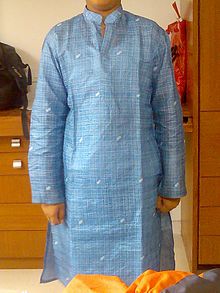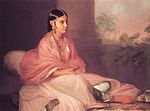Khadi

Khadi(pronounced[kʰaːdiː],Khādī), derived fromkhaddar,[1][2][3]is a hand-spun and wovennatural fibrecloth promoted byMahatma Gandhiasswadeshi(self-sufficiency) for the freedom struggle of theIndian subcontinent,and the term is used throughoutIndia,PakistanandBangladesh.[4][5]The first piece of the hand-woven cloth was manufactured in theSabarmati Ashramduring 1917–18. The coarseness of the cloth led Gandhi to call itkhadi.[6]The cloth is made fromcotton,but it may also includesilkorwool,which are all spun into yarn on acharkha.It is a versatile fabric that remains cool in summer and warm in winter. To improve its appearance, khadi is sometimesstarchedto give it a stiffer feel. It is widely accepted in various fashion circles.[7]
Greco-Romanmerchants imported finer cotton in large quantities to theRoman Empire.In medieval times, cotton textiles were imported to Rome through themaritime Silk Road.Arabian-Suratmerchants traded cotton textiles toBasraandBaghdadfrom three areas of Gujarat, theCoromandel Coastand the East Coast of India. To the east, trade reached China via Java. 14th-century Moroccan travelerIbn Battutamentioned Delhi sultanMuhammad bin Tughluqsending five varieties of cloth to the Yuan emperor in China.[8]Some of the textiles are stored in repositories of the Victoria and Albert Museum, London.[9]




After theFirst Indian War of Independencein 1857, domestic textile production by mill or traditional methods declined to its lowest levels before khadi emerged as a "silent economic revolution" as an outcome of a long and laborious evolutionary process.[10]
TheAmerican Civil War(1861–1865) caused raw cotton crisis inCottonopolisBritain. Indian cotton at cheap prices was sourced for them as the textile industry did not exist in India, and hand spinning was a dying art. DuringVictorian era(1837–1901), 47 mills existed in the 1870s but Indians still bought clothes at an artificially inflated price, since thecolonial governmentexported the raw materials for cloth to British fabric mills, then re-imported the finished cloth to India.[11][better source needed][12]In theEdwardian era(1901–1914) theSwadeshi movementof boycotting foreign cloth remained prominent.[13]During the first two decades of the 20th century it was backed bynationalist politiciansand Indian mill owners.
In 1922,Mahatma Gandhirequested the Indian National Congress (INC) to start a khadi department. In 1924, due to a large amount of work, a semi-independent body All India Khadi Board (AIKB) was formed which liaisoned with the INC's khadi department at the provincial and district levels. In 1925, the All India Spinner Association (AISA) was formed comprising the khadi department and AIKB. Mahatma Gandhi was the founder of AISA. He made it obligatory for all members of the INC to spin cotton themselves and pay their dues in yarn. Gandhi collected large sums of money to create grassroots-level khadi institutions to encourage spinning and weaving which were certified by AISA.[citation needed]Handspun yarn was expensive and of poor quality, and weavers preferred yarn produced by mills because it was more robust and consistent in quality. Gandhi argued that the mill owners would deny handloom weavers an opportunity to buy yarn because they would prefer to create a monopoly for their own cloth.[14]When some people complained about the costliness of khadi to Gandhi, he only woredhoti,though he used wool shawls when it got cold. Some were able to make a reasonable living by using high-quality mill yarn and catering to the luxury market. Gandhi tried to put an end to this practice by threatening to give up khadi altogether, but since the weavers would have starved if they listened to him, they ignored the threat.[15]In 1919, Gandhi started spinning at Mani Bhawan Mumbai and encouraging others to do so. He invented Patti Charkha, using a double-wheel design to increase speed and control while reducing size. In 1946, when huge funds were being spent on development for more productive charkhas, he recommended takli over charkha.[16]
The khadi movement began in 1918 and was marked with its own changing dynamics. Initially, a clear emphasis could be seen on using khadi as an economic solution due to stagnation, from 1934 onwards the fabric became something that villagers could use for themselves.[17]
In 1921, Gandhi went toChandina Upazilain Comilla, Bangladesh, to inspire local weavers and consequently in the greaterComillaregion, weaving centers were developed inMainamati,Muradnagar,Gauripur and Chandina.[18]
Khadiin post-independence India[edit]
In 1948, India recognized the role of rural cottage industries in its Industrial Policy Resolution. In 1948, Shri Ekambernathan invented ambercharkha.The All India Khadi & Village Industries Board (AIKVIB) was set up in January 1953 by the Government of India. In 1955 it was decided that a statutory body, theKhadi and Village Industries Commission(KVIC), should replace the Board and the KVIC Act was passed in 1956, which brought the KVIC into existence as a statutory organisation the following year.[19]
After Independence, the government reserved some types of textile production, such as towel manufacturing for thehandloomsector, which resulted in a deskilling of traditional weavers and a boost for thepower loomsector. Private sector enterprises have been able to make handloom weaving somewhat remunerative and the government also continues to promote the use of Khadi through various initiatives.[15][20]
Prime MinisterNarendra Modiduring Khadi Utsav (27 Aug 2022), said "Khadi was ignored after Independence due to which weavers in the country suffered"[21]and asserted that khadi is a movement to help the poor, and further claimed that the KVIC is a statutory organisation engaged in promoting and developing khadi and village industries.[22]
Muslin (khadi) in Bangladesh[edit]
The Pakistan government saw khadi as emblematic of the ideology of Congress that had led thenon-cooperation movement,so khadi organisations like the Noakhali Ambika Kalinga Charitable (NAKC) Trust, started on Gandhi's visit in 1946, were discouraged. Pakistan prime ministerFiroz Khan Noon(1957–58), who remained Governor East Pakistan (1950-1953) was liberal towards khadi and established The Khadi and Cottage Industry Association in 1952.Sheikh Mujibur Rahman's historic 7 March speech of Bangabandhu refueled the momentum to produce khadi. A sudden wave of demand persisted in Bangladesh for many years after the country's independence from Pakistan in 1971. In 1975, some years after the independence of Bangladesh, the NAKC trust was reformed and renamed theGandhi Ashram Trust.[23]
Muslin was registered under Bangladesh as itsgeographical indicationin 2020.[24]
The soft or refined khadi is known as muslin khadi. Researchers have tried to replicate muslin and identifiedphuti carpasas the variety from theDNAofcottonand from motifs used in making muslin sarees fromVictoria & Albert MuseumLondon of 1710 collection with 350 muslin sarees.[25]
Trademark[edit]
The KVIC holds the exclusive rights to use the trademarkskhadiandKhadi India.The National Internet Exchange of India Domain Dispute Policy Arbitration Tribunal in New Delhi rejected a private entity's claim thatkhadiis a generic word.[26][27][28]In 2017, KVIC and the government of India fought a case[29]at theEUIPOagainst a German company that had trademarked the word. While KVIC obtained the latest trademark registration in Bhutan on 9 July 2021; trademark registration was granted in UAE on 28 June 2021, and the organisation registered the trademark in Mexico in December 2020.[30]
Legacy[edit]
The KVIC enrolled 2624 functional Khadi institutions[31]in India where decentralized units ofKshetriya Shri Gandhi AshraminUttar PradeshandUttarakhand,Zila Khadi Gramodyog Sangh[32]inBiharandJharkhand,Sarvodaya Sangh[33]inTamilnaduhave survived as the oldest operational Khadi organisations.[34]
See also[edit]
References[edit]
- ^"Khadi, Khāḍi, Khādi: 10 definitions".wisdomlib.org.3 August 2014.Retrieved26 October2020.
- ^wplly (19 April 2019)."The Origin of Khadi Fabric | Historical Story of Khadi".Khadi Cotton.Archived fromthe originalon 7 November 2020.Retrieved26 October2020.
- ^"Khadi | Definition of Khadi by Oxford Dictionary on Lexico also meaning of Khadi".Lexico Dictionaries | English.Archived fromthe originalon 29 October 2020.Retrieved26 October2020.
- ^"The Fascinating History of the Fabric That Became a Symbol of India's Freedom Struggle".The Better India.12 April 2017.Retrieved8 August2017.
- ^"Freedom@70: How Khadi is getting a new spin",The Economic Times,13 August 2017.
- ^Gonsalves, Peter (April 2015)."Clothing Choices in Gandhi's Swadeshi Movement".Gandhi Marg.37(1).
- ^"Khadi".getcopaycom.ipage.Archived fromthe originalon 27 July 2020.Retrieved27 July2020.
- ^Islam, Khademul."Our Story of Dhaka Muslin".Aramco World.Retrieved1 June2016.
- ^"Collections Search: Khadi".Victoria and Albert Museum.
- ^The Story of Silent Economic Revolution.Bombay: Khadi & Village Industries Commission. 1958.OCLC1174022.
- ^Black, Carolyn (2003).Pakistan: The People.Crabtree Publishing Company. p. 8.ISBN978-0-7787-9347-2.
- ^Mahesh, Aggarwal R. C. /Bhatnagar (27 July 2005).Constitutional Development & National Movement in India.S. Chand Publishing.ISBN9788121905657– via Google Books.
- ^"Historical background of Khadi".chandrakantalrks.org.Archived fromthe originalon 22 October 2017.Retrieved8 August2017.
- ^Sinha, Sangita."The Story Of Khadi, India's Signature Fabric".Culture Trip.Retrieved8 August2017.
- ^ab"Saturday Dressing: Kerala govt staff opt for khadi".Business Standard.Press Trust of India. 6 January 2007.Retrieved20 March2016.
- ^Shepard, Mark (27 July 2016)."Charkha Master A Meeting with Narayan Desai".
- ^Gandhi, M.K (1955).Gandhiji on Khadi(PDF).Navajivan Publishing House.
- ^"The story of Khadi".Star LifeStyle.Dhaka: The Daily Star. 13 December 2011.Retrieved14 January2014.
- ^Parekh, Geetanjali (2010).History of Khadi.NBT National Book Trust. pp. 38–39.ISBN978-8123760421.Retrieved24 March2017.
- ^"Mann Ki Baat: PM Modi urges India to embrace Gandhi's legacy 'Khadi'".Zee News.1 February 2016.Retrieved10 June2016.
- ^@PTI_News (27 August 2022)."Khadi was ignored after Independence due to which weavers in the country suffered: PM Modi. PTI KA PD KRK"(Tweet) – viaTwitter.
- ^"PM Modi in Mann Ki Baat: Khadi not a cloth, but a movement to help the poor".Business Standard.24 September 2017.Retrieved6 April2018.
- ^Bhuiyan, Mohammed."Fashion output on Khadi in Bangladesh: A Review".Research Gate.Retrieved1 December2017.
- ^Kalam, Abdul."GI recognition Muslin belongs to Bangladesh".Good Day Bangladesh.Retrieved1 January2021.
- ^"Muslin Khadi".West Bengal Khadi & Village Industries Board (WBKVIB). 29 October 2018.
- ^"Tribunal bars unauthorised use of Khadi brand name".Indiaretailing.21 May 2021.Retrieved23 May2021.
- ^"'Khadi', 'Khadi India' not generic names, rules tribunal ".The Hindu.20 May 2021.ISSN0971-751X.Retrieved23 May2021.
- ^"KVIC: Court bars individuals/cos from using 'Khadi' brand name without authorisation".millenniumpost.in.20 May 2021.Retrieved23 May2021.
- ^Shairwal, Sakshar Law Associates-Sakshi (22 June 2021)."Khadi v Khadi - Khadi's Plight in the EUIPO".Lexology.Retrieved15 August2022.
- ^"KVIC Secures Trademark Registrations in Bhutan, UAE & Mexico; Files Applications in 40 Countries to Protect Brand" Khadi "".Orissa Diary.
- ^"Khadi Institutions Profiles".KVIC.Retrieved11 July2022.
- ^"Industrial Decentralization-A Case Study of Khadi and Village Industries in Jharkhand".Research Gate. p. 511.Retrieved12 July2022.
- ^"A STUDY ON OPERATIONAL EFFICIENCY OF SARVODAYA SANGHS IN VIRUDHUNAGAR DISTRICT"(PDF).Madurai Kamraj University. pp. 2–3.Retrieved12 July2022.
- ^"Report on Re-categorisation of Khadi Institutions Revised Framework and Analysis"(PDF).KVIC. p. 2.Retrieved12 July2022.
External links[edit]
- Khadi Culture: Fabrics from the roots of a nation!
- India's Khādī Culture
- Khadi and Village Industries Commission(Government of India), official website
- Gul Ahmed's Khadi Collection– Explore a range of Khadi fabrics from Gul Ahmed.
- More about Khadi

